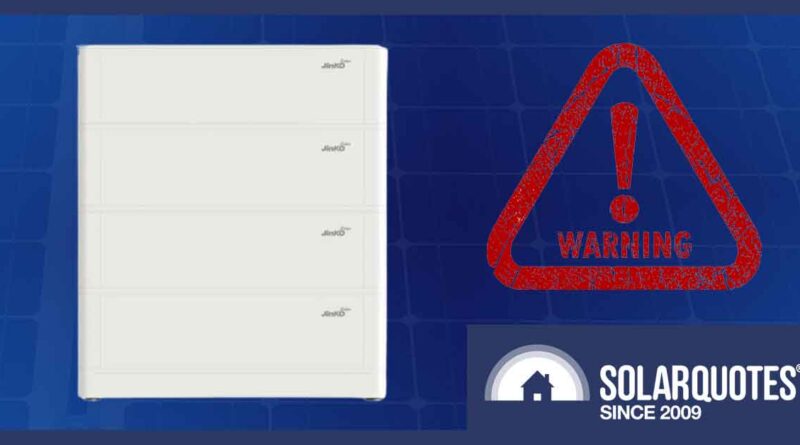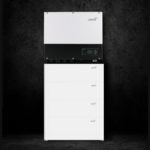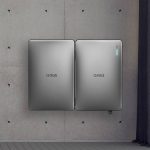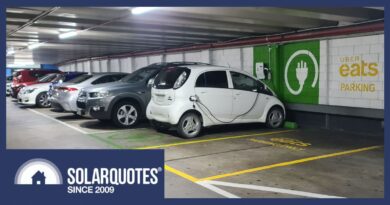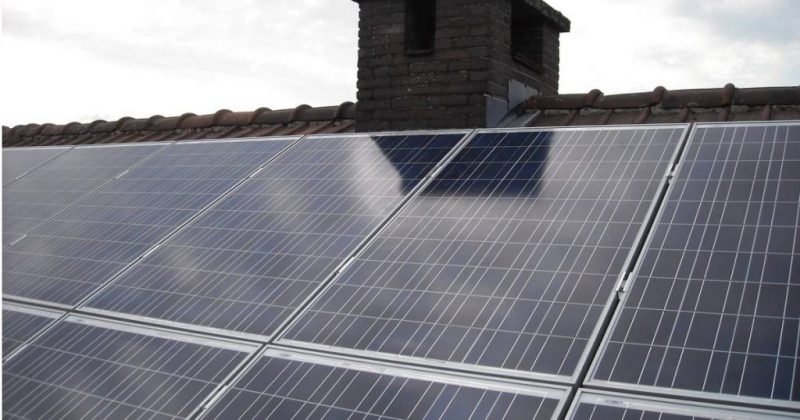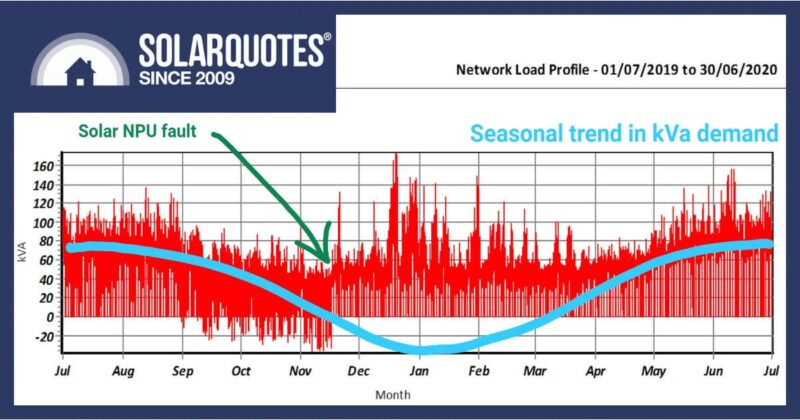Drowning In Despair: A Deep dive Into The Jinko Solar Suntank Warranty
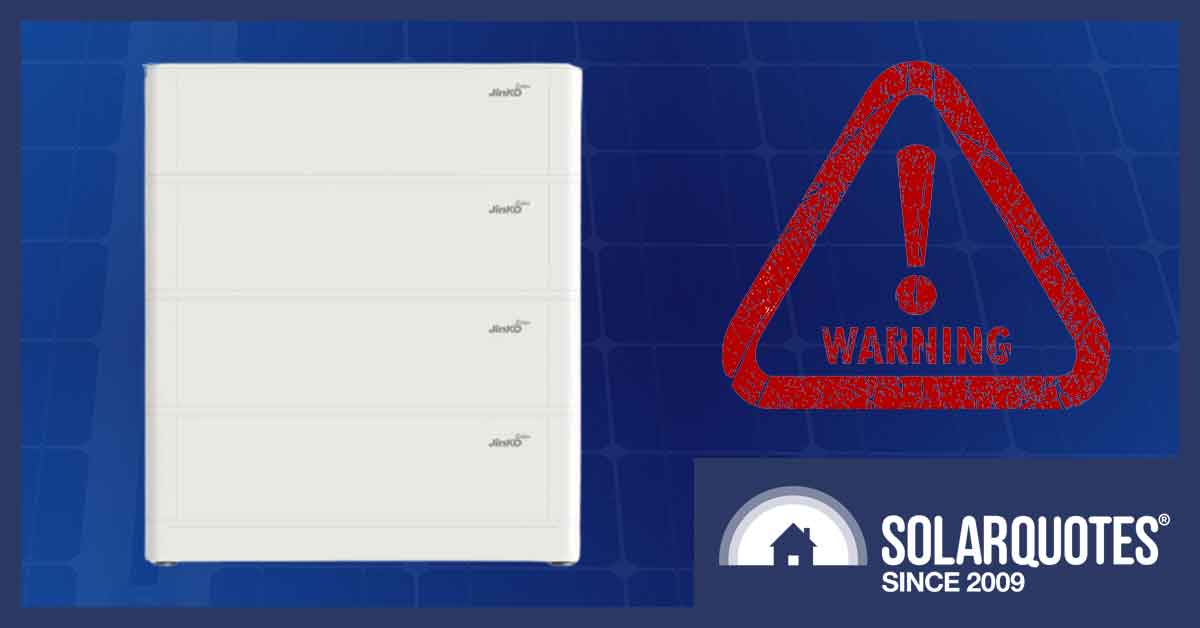
Jinko Solar launched their Suntank low-voltage home battery in July 2022. This article is my opinion of its warranty. While it’s possible the battery could be good, I can tell you right now its warranty isn’t.
Jinko has provided the Suntank battery with the type of warranty I’d expect from a no-name manufacturer that disappears once they realise Australian consumer law applies regardless of what’s in their warranty fine print. It’s very disappointing, given Jinko solar panels have an excellent reputation for being reliable and well-supported in Australia.
Jinko claims the battery has a 10 year warranty, but if used for more than one full cycle per day – common for many already installed home batteries – the warranty can easily end in four years or less. In some cases, after a single year.
Read on if you want to find out just how bad I think the Suntank warranty is. But first, I’ll briefly explain what the Suntank is.
The Suntank Modular Low Voltage Battery
The Suntank is a modular, low-voltage battery. The modular part means you can stack modules from one to ten high:

The Suntank home battery can have from 1 to 10 modules for 2.3 to 23kWh of usable energy storage. You can also have multiple stacks.
Each module has 2.3 kilowatt-hours (kWh) of usable storage when new, and it’s possible to have just one module, making a very small home battery. If you want to check out its tech specs, here’s the datasheet.
A Suntank battery requires a Suntank hybrid inverter, and its datasheet is here. Because the battery system is low voltage, the cables that connect it to the inverter need to carry high current, and are thick and heavy, so they must be closely co-located.
Now you know, in a nutshell, what the Suntank battery is — I’ll tell you what it isn’t. It isn’t covered by a good warranty. It has two major problems. The first is terrible, while the second goes beyond terrible and dwells in a dark dimension all of its own.
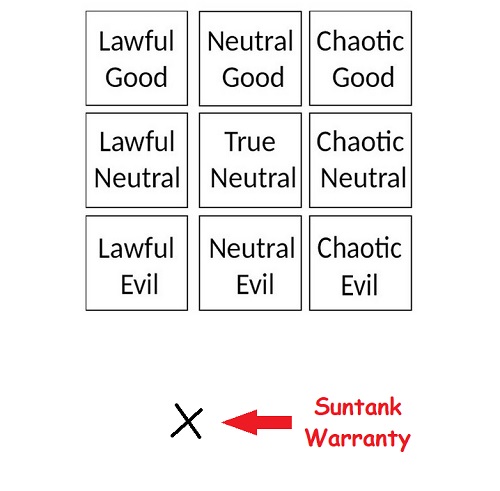
This is my opinion of where the Suntank warranty falls on the above graph. (As you can see, I like to think outside of the box.)
If you want to check out the warranty document for yourself, you can find it here.
1st Huge Problem: 50% Capacity Retention
The warranty only promises the Suntank battery will retain a minimum of 70% of its nominal energy capacity of 2.56kWh per module in the first five years of its — potentially — 10 year warranty. In the last 5 years, it only promises 50%. This is worse than any reputable home battery on the Australian market. While it may not seem much worse than the 60% minimum retention some battery warranties offer, these generally allow far more kWh to be discharged before they end. The total amount of energy the Suntank battery can discharge without the warranty ending early — potentially very early — is very low.
2nd Even Worse Problem: Warranty Can Self Destruct
If you want the warranty for the Suntank’s battery modules to last a full 10 years, then in each year of use, no more than the “Yearly Usable Rate” of 768kWh can be discharged from each module. This is an average of 2.1kWh per module per day which is 91% of its usable storage capacity when new and only 82% of its nominal storage capacity.
If 783kWh are discharged per module per year — just 2% more than the 768kWh limit — then the warranty will only last 8 years. That’s bad, but it rapidly gets worse than that. If you use 10% more than the limit the warranty lasts 3 years. Worst of all, if you commit the perfectly reasonable — but apparently unforgivable — act of discharging 22% more than that limit per year the warranty will self-destruct after one year.
Other Batteries Do Much Better
In comparison, if the following batteries were used to provide the equivalent amount of stored energy that was just enough to destroy the Suntank’s warranty after one year, their warranties would last…
- Tesla Powerwall 2: 6.7 years1
- BYD Battery Box Premium HVM: 7.4 years
- Sungrow SBR HV: 10 years
The Warranty Bomb Equation
In the Suntank warranty, there’s a hideous equation that can cause it to self-destruct after a single year. The warranty, that is, not the battery. I’ll put a screenshot below so you can see how bad it is. WARNING: Do not attempt to work through it without arithmetic protection. It will kill you:
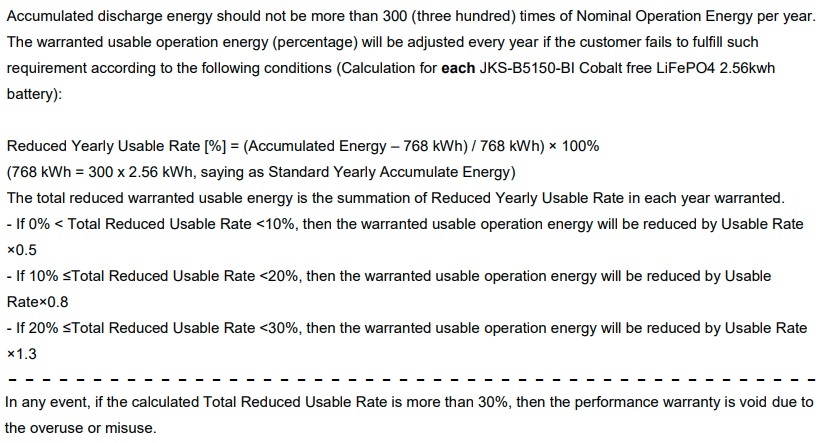
I’m not making this up. It’s actually this complicated.
If you are a maths teacher, you can see that’s an annoying equation. If you’re not a maths teacher, avert your eyes now! Direct eye contact will damage the calculation centres of your brain.
Because the warranty does not give clear instructions on how to use the equation, I’ve used the most optimistic interpretation possible. So it could be worse than I think it is.
4 Scenarios From Lousy To Disastrous
To show how terrible the warranty is, I’ll work out how long it will last under three different conditions. I would call them the good, the bad, and the ugly — but because the warranty only promises the battery will retain 50%+ of its capacity — they’re actually the bad, the ugly, and the freaking disastrous.
- The Bad: Per module, a daily average of 2.1kWh or less is discharged.
- The Ugly: Per module, a daily average of 2.3-2.41kWh is discharged.
- The Freaking Disastrous: Per module, a daily average of 2.41kWh or more is discharged.
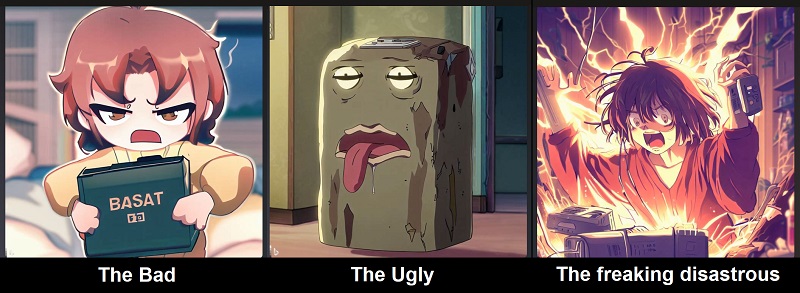
This is what I got when I asked for these home batteries in anime style from the DALL-E Image Creator.
The Bad
The first scenario is the best possible outcome as far as the warranty is concerned. As long the amount of energy discharged per module is kept at the Yearly Usable Rate of 768kWh or below, the warranty will last 10 years. If you go 1% above the warranty will still last 10 years, so you don’t have to worry about leap days dropping the warranty below 10 years, but going 2% or more over will end the warranty early.
The Ugly
If a household discharges a daily average of 2.3kWh per module — an amount equal to its usable energy storage when new — then after one year it will have discharged 839.5kWh. If this amount is discharged every year the warranty will self-destruct.
Here are the steps you have to follow after one year to work out how much trouble you’re in:
- Take the number of kWh discharged by the battery over a year and subtract 768 from them. In this case, it will be 839.5 minus 768 which gives 71.5.
- Divide 71.5 by 768. This gives 0.0931.
- Times by 100%. This will be 0.0931 times by 100% which gives 9.31%.
- Because 9.31% is greater than 0% but less than 10% you must multiply it by 0.5 to get 4.65%.
- The Yearly Usable Rate of 768kWh must then be reduced by 4.65% to give 732.25kWh.
It’s not exactly easy, is it? It’s also bizarre because you don’t have to do sums every year to work out how your TV or e-bike warranty is holding up. Note you don’t do this just once for the battery as a whole. It has to be done for every module in the system.
So how does this lead to warranty destruction? Well, the next year you need to do the same calculation again, but instead of subtracting 768 from the number of kWh discharged, you now have to subtract the Reduced Yearly Usable Rate of 732.25kWh.
If exactly the same amount of energy is discharged in the second year, then step 3 in the calculations will give 13.93%. Because this is more than 10% and less than 20% it’s multiplied by 0.8 to get 11.15%. When that’s subtracted from the Reduced Yearly Usable Rate it becomes 650.63kWh.
In the third year, step 3 will give us 24.59%. Because this is more than 20% but less than 30%, we must multiply it by 1.3. This gives 31.97%. Because this figure is greater than 30% it means the warranty ends after just three years. This is because of the warranty condition that says:
“In any event, if the calculated Total Reduced Rate is more than 30%, then the performance warranty is void due to the overuse or misuse.”
Now that’s bloody cheeky! For most other batteries, it would be normal use — not over or misuse!
Freaking Disastrous
If a daily average of 2.42 to 2.55kWh are discharged from a module, then the warranty will only last two years. Worse still, if the average daily discharge is equal to its nominal storage capacity of 2.56kWh or more, then the warranty will be void after a single year. Now that’s freaking disastrous.

For some reason, whenever I try to print a hard copy of the warranty, it comes out looking like this. (Image Credit: Still from the movie Evil Dead 2.)
Capacity Loss May Extend The Warranty
In the above examples, I assumed the same amount of energy would be discharged from the battery each year. But if the battery’s capacity falls, then the energy discharged each year may also fall. Because the warranty allows for a lot of capacity deterioration, this could potentially add a year or more to how long the warranty lasts.
Of course, if the only reason a battery warranty lasts as long as it does is that its capacity is rapidly deteriorating, that is a disaster in itself.
Modules May Not Discharge Evenly
Ideally, all the modules in a Suntank system would discharge almost identical amounts of energy. But this may not be the case and some modules in a stack may consistently discharge more or less than the others. It’s also possible the difference in output between modules will increase over time. So a battery system may appear safe from warranty self-destruction, but individual modules may have reduced or completely ruined warranties.
Small Battery = High Warranty Risk
Its terrible warranty makes one of the apparent benefits of the Suntank battery — the ability to have a small battery system — a liability. This is because the smaller the battery, the harder it generally works. This is because small batteries…
- Are more likely to be fully drained overnight.
- Are more likely to be fully charged during the day.
- Small discharges and recharges during the day use a larger portion of their capacity. A daytime discharge that’s 5% the capacity of a new 13.5kWh Powerwall 2 will be 29% the usable capacity of a new single-module Suntank battery and close to 15% that of a two-module system.
Many larger home batteries are used at an average daily capacity factor of around 80% or less. But it’s not difficult for small batteries to be used at 100% capacity or higher. Because using the Suntank battery at a daily average of over 91% of its usable capacity when new will destroy its warranty in one to four years, small systems are at high risk of warranty self-destruction.
VPPs Are A Risk
Joining a Virtual Power Plant (VPP) will increase the amount of energy a Suntank discharges and put it at risk of warranty self-destruction. While VPPs vary in how hard they work batteries, they all have the potential to be problematic.
Can Battery Settings Preserve Warranty? Beats Me!
After forcing myself to read through the abysmal warranty, the first coherent thought that emerged from my badly abused mind was…
“Is it possible to set the battery so each module never uses more than 768kWh per year? Alternatively, can the depth of discharge be reduced to make exceeding that amount unlikely or impossible?”
To find out, I tried to look up the installation manual online, but I couldn’t find it. I did find a page for downloading it, but Jinko hasn’t finished it yet…

If you are wondering what the text is, it’s a Latin Bible verse. While my Latin is a little rusty, I think it’s the one about orangutans and breakfast cereal…
Fortunately, Jinko has a copy of the installation manual online here. Looking through it, I see no mention of how to stop its warranty from self-destructing. I have contacted Jinko to ask if anything can be done. If they give any advice, I’ll let you know.
No Monitoring = 3 Years Warranty.
One of the warranty requirements is that it must be connected to the internet so Jinko can monitor it. If it isn’t connected, then the warranty only lasts three years. But it’s still possible for the warranty to self-destruct before that, in a way similar to a monitored battery. This means you can’t benefit by not connecting it to the internet and getting three years of warranty instead of potentially one.
1 Year Smartmeter & Wireless Warranty
The battery requires a Jinko smart meter and a wireless monitoring module to be connected to the internet. Both these items only have a 12 month warranty. So the battery system, which supposedly has a 10 year warranty, is dependent upon components with one year warranties. This is a major problem and I’d normally complain about it at length, but it’s overshadowed by the warranty’s super major problems.
Warranty Exclusions
As with every battery warranty, a whole list of exclusions render it void. These mostly boil down to…
- The battery must be installed and used according to the manual.
- It can’t be hacked or modified in any way without permission.
- The warranty doesn’t cover anything that isn’t Jinko’s fault.
There are a few exclusions I’ll mention specifically. One is…
- “Outdoor installation or outdoor usage without proper shelter.”
While the datasheet gives its Ingress Protection (IP) rating as IP65, which means it should be able to withstand rain without harm, they still don’t want the Suntank exposed to the elements. The installation manual states it must be protected from rain and direct sunlight.
- “Fail to meet the operating environmental requirement: charging temperature -10°C to +45° C, discharging temperature -10°C to +45°C…”
This should be on the battery manufacturer. If they don’t want charging or discharging outside of a temperature range it should shut down by itself. That’s how home batteries normally operate, but this exclusion makes it sound as though it’s the owner’s responsibility.
- “This warranty does not cover superficial or cosmetic defects, dents, marks or scratches, which do not affect the proper function of the battery, especially for warranty replacement devices.”
So if the battery system is ugly the warranty won’t cover it, and if they replace it, the replacement can also be ugly.
It’s Non-Transferrable
The warranty says it can’t be transferred, so if you sell your home, you can’t pass it on to its new owner. This is annoying but may be less of a problem than most home batteries, given that the warranty may have already self-destructed by the time you want to move.
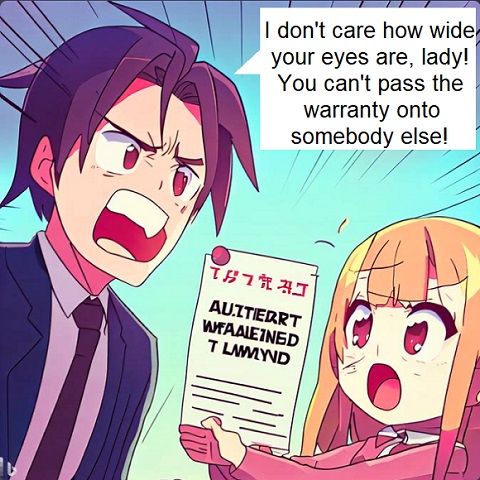
I asked DALL-E to produce another picture in anime style. Also, DALL-E can’t spell. In any language.
What Jinko Will Do
In the first 5 years of the warranty, if the battery becomes defective due to…
“…material defect in design, materials and workmanship that impair the performance of the Goods.”
…then Jinko will either repair it or provide a replacement. The specific wording they use is…
“Exchange for a replacement device of equivalent value according to the model and age.”
So if they replace it, you may not get a new Suntank battery. They can give something else of “equivalent value” and don’t explain how that value will be determined. The warranty also states that if the new system isn’t compatible, costs that are incurred as a result are not covered.
In the final 5 years of the 10 year warranty — assuming it lasts that long — the warranty says that instead of a repair or replacement, Jinko Solar can give you a “pro rata / proper price”. So if three years are left in the warranty, you may be given 30% of the system’s price. The warranty also says it’s completely up to Jinko whether they give you a repair, replacement, or pro-rata refund.
Another thing Jinko claims they can do in the final five years of the warranty, again, entirely at their discretion, is…
“…renew it by a recent technology brand new product with a reasonable price payable by the customer.”
Now if this was offered as an option, that would be one thing. But the way I’m reading this is Jinko can decide to fulfil their warranty obligations by giving you a discount on a new system you have to pay for. That is in no way acceptable, in my opinion. Maybe when that one breaks down, the only option they’ll offer is to make you buy another new one?
Doesn’t Cover Losses Or Labour
The warranty says it doesn’t cover losses resulting from anything. It also says it won’t cover labour or logistics costs. I presume logistics includes transport costs.
The Last Sentence Is A Doozy…
The final sentence of warranty is…
“Jinko reserves the right to modify or update this Limited Warranty at any time, with or without notice.”
At any time? Do they mean they can change it after the battery has been bought? If they do mean that, they can void the warranty whenever they feel like it. This would be nuts. Here’s a sentence they should add to make things clear:
“The warranty conditions will always remain those that apply at the time of purchase.”
Australian Consumer Law
Fortunately, you are protected by Australian Consumer Guarantees that apply no matter what’s in the warranty. You can read about the strong consumer protection they provide here.
While I am not a lawyer, it looks as though Jinko is at considerable risk of having to support batteries for the full 10 years, even if the self-destruct equation says the warranty ended after just one year. This is because Jinko has made no effort to clarify that normal home battery use in Australia can rapidly destroy its warranty. Its datasheet states it has a 10 year warranty, but the only way to find out that’s not really true is through the following three-step process:
- Have a good understanding of how home batteries are used.
- Read the warranty and find and understand its self-destruct equation.
- Do annoying 7th grade maths to find out how bad the warranty actually is.
That’s too much to ask of a typical Australian looking for a reliable home battery. If they said the battery had a 1-10 year warranty depending on usage, they’d have a leg to stand on. But at the moment, it’s like they’ve downed an entire flagon of cheap port. They’re utterly legless.
My Advice
In case you haven’t guessed by now, I don’t advise buying this battery. Not with its current warranty. Jinko may improve it, but I doubt they’ll change it enough to make it worthwhile. If the battery could support a significantly better warranty, it would probably already have one. Perhaps the Suntank could suit someone who’s certain they’ll stay below the warranty self-destruct limit, but I don’t see why they wouldn’t just get a battery with a better warranty.
I am morose over the fact Jinko Solar’s first battery has a warranty that makes it completely unrecommendable. All I can hope for is the high-voltage battery they intend to release in the future will be miles ahead of this disappointing product.
Footnotes
- This assumes the Powerwall 2 is used under the warranty condition that allows for 37,000kWh of energy throughput. ↩
Original Source: https://www.solarquotes.com.au/blog/jinko-solar-suntank-warranty/

